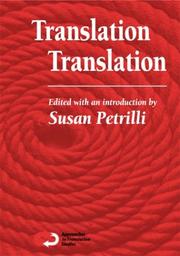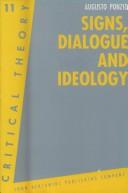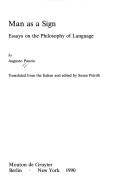| Listing 1 - 10 of 34 | << page >> |
Sort by
|

ISBN: 9042009470 9789042009479 9789004490093 9004490094 Year: 2003 Volume: 21 Publisher: Amsterdam: Rodopi,
Abstract | Keywords | Export | Availability | Bookmark
 Loading...
Loading...Choose an application
- Reference Manager
- EndNote
- RefWorks (Direct export to RefWorks)
In this theoretical framework essays have been included not only from major translation experts, but also from researchers working in different areas, in addition to semiotics and linguistics, also philosophy, literary criticism, cultural studies, gender studies, biology, and the medical sciences. All scholars work on problems of translation in the light of their own special competencies and interests. Translation Translation contributes to current debate on the question of translation dealt with in an interdisciplinary perspective, with implications not only of a theoretical order but also of the didactic and the practical orders. In the context of globalization the question of translation is fundamental for education and responds to new community needs with reference to Europe and more extensively to the international world. In its most obvious sense translation concerns verbal texts and their relations among different languages. However, to remain within the sphere of verbal signs, languages consist of a plurality of different languages that also relate to each other through translation processes. Moreover, translation occurs between verbal languages and nonverbal languages and among nonverbal languages without necessarily involving verbal languages. Thus far the allusion is to translation processes within the sphere of anthroposemiosis. But translation occurs among signs and the signs implicated are those of the semiosic sphere in its totality, which are not exclusively signs of the linguistic-verbal order. Beyond anthroposemiosis, translation is a fact of life and invests the entire biosphere or biosemiosphere, as clearly evidenced by research in "biosemiotics", for where there is life there are signs, and where there are signs or semiosic processes there is translation, indeed semiosic processes are translation processes. According to this approach reflection on translation obviously cannot be restricted to the domain of linguistics but must necessarily involve semiotics, the general science or theory of signs.
Theory of literary translation --- Literary semiotics --- Translation science --- Sociolinguistics --- Translating and interpreting --- Semiotics --- #KVHA:Vertaalwetenschap --- #KVHA:Vertaaltheorie --- Peirce, Charles S. --- Semiotiek --- Vertaalwetenschap --- Vertalen en filosofie --- Vertalen en semiotiek --- Semiotiek. --- Vertaalwetenschap. --- Vertalen en filosofie. --- Vertalen en semiotiek. --- Biosemiotics --- Character --- Cybernetics --- Text theory --- Semeiotics --- Semiology (Linguistics) --- Semantics --- Signs and symbols --- Structuralism (Literary analysis) --- Mechanical brains --- Control theory --- Electronics --- System theory --- Ethology --- Ethics --- Personality --- Sémiotique --- Traduction
Book
ISBN: 1614515220 1614519129 9781614519126 9781614515227 9781614517191 1614517193 1614515239 Year: 2014 Publisher: Boston : De Gruyter,
Abstract | Keywords | Export | Availability | Bookmark
 Loading...
Loading...Choose an application
- Reference Manager
- EndNote
- RefWorks (Direct export to RefWorks)
This book examines the issues surrounding the problematic perpetuation of dominant sign systems through the framework of 'semioethics'. Semioethics is concerned with using semiotics as a powerful tool to critique the status quo and move beyond the reproduction of the dominant order of communication. The aim is to present semioethics as a method to engage semiotics in an active rethink of our ability as humans to affect change.
Semiotics. --- Semiotics --- Language and ethics. --- Ethics and language --- Ethics --- Semeiotics --- Semiology (Linguistics) --- Semantics --- Signs and symbols --- Structuralism (Literary analysis) --- Moral and ethical aspects. --- Philosophy. --- Semiotics, Communication.
Book
Year: 1992 Publisher: Berlin de Gruyter
Abstract | Keywords | Export | Availability | Bookmark
 Loading...
Loading...Choose an application
- Reference Manager
- EndNote
- RefWorks (Direct export to RefWorks)
Book
Year: 2001 Publisher: Berlin Mouton de Gruyter
Abstract | Keywords | Export | Availability | Bookmark
 Loading...
Loading...Choose an application
- Reference Manager
- EndNote
- RefWorks (Direct export to RefWorks)
Multi
ISBN: 9781614515227 9781614519126 9781614517191 1614519129 1614515220 Year: 2014 Publisher: Berlin Boston
Abstract | Keywords | Export | Availability | Bookmark
 Loading...
Loading...Choose an application
- Reference Manager
- EndNote
- RefWorks (Direct export to RefWorks)
This book examines the issues surrounding the problematic perpetuation of dominant sign systems through the framework of 'semioethics'. Semioethics is concerned with using semiotics as a powerful tool to critique the status quo and move beyond the reproduction of the dominant order of communication. The aim is to present semioethics as a method to engage semiotics in an active rethink of our ability as humans to affect change.
Linguistics --- Semiotics. --- Semiotics --- Language and ethics. --- Moral and ethical aspects. --- Philosophy.
Digital
ISBN: 9783110218510 9783110218503 Year: 2009 Publisher: Berlin ;; Boston De Gruyter Mouton
Abstract | Keywords | Export | Availability | Bookmark
 Loading...
Loading...Choose an application
- Reference Manager
- EndNote
- RefWorks (Direct export to RefWorks)

ISBN: 0802087655 1442657111 9781442657113 0802094295 1442685689 1442659076 144269209X Year: 2005 Publisher: Toronto, [Ontario] ; Buffalo, [New York] ; London, [England] : University of Toronto Press,
Abstract | Keywords | Export | Availability | Bookmark
 Loading...
Loading...Choose an application
- Reference Manager
- EndNote
- RefWorks (Direct export to RefWorks)
Semiotics Unbounded offers a new and original survey of the science of signs, evaluating it in relation to the problems of our time, not only of a scientific order, but also the problems concerning everyday social life.
Language and languages --- Language --- Semiotics --- Semiotics. --- Langage et langues --- Sémiotique --- Sémiotique. --- Philosophy. --- Research. --- Philosophie. --- Recherche. --- Research --- Philosophy --- Semeiotics --- Semiology (Linguistics) --- Hebrew language --- Syntax. --- Semantics --- Signs and symbols --- Structuralism (Literary analysis)

ISBN: 9027224218 9786613358516 1283358514 9027276935 9789027276933 9781556191794 1556191790 1556191790 9789027224217 Year: 1993 Publisher: Amsterdam Philadelphia J. Benjamins
Abstract | Keywords | Export | Availability | Bookmark
 Loading...
Loading...Choose an application
- Reference Manager
- EndNote
- RefWorks (Direct export to RefWorks)
Signs, Dialogue and Ideology illustrates and critically examines - both historically and theoretically - the current state of semiotic discourse from Peirce to Bakhtin, through Saussure, Levinas, Schaff and Rossi-Landi to modern semioticians such as Umberto Eco.Ponzio is in search of a method to construct an appropriate language to talk about signs and ideology in this "end of ideology" era. Ponzio aims at an orientation in semiotics based on dialogism and interpretation by calling attention to the widespread transition from the semiotics of decodification to the semiotics of interpreta
Identity (Philosophical concept). --- Ideology. --- Semiotics. --- 82:003 --- Identity --- Ideology --- Semiotics --- Semeiotics --- Semiology (Linguistics) --- Semantics --- Signs and symbols --- Structuralism (Literary analysis) --- Knowledge, Theory of --- Philosophy --- Political science --- Psychology --- Thought and thinking --- Comparison (Philosophy) --- Resemblance (Philosophy) --- 82:003 Semiotiek in de literatuur --- Semiotiek in de literatuur --- Identity (Philosophical concept) --- Semiótica --- Ideologías

ISBN: 3110121670 3111784215 3110874423 9783110874426 0899256023 9780899256023 9783110121674 Year: 1990 Volume: 89 Publisher: Berlin New York
Abstract | Keywords | Export | Availability | Bookmark
 Loading...
Loading...Choose an application
- Reference Manager
- EndNote
- RefWorks (Direct export to RefWorks)
No detailed description available for "Man as a Sign".
Semiotics. --- Language and languages --- Philosophy. --- Semeiotics --- Semiology (Linguistics) --- Semantics --- Signs and symbols --- Structuralism (Literary analysis) --- Semiotics --- Addresses, essays, lectures --- Philosophy --- Languages - Philosophy. --- Philosophy of language
Book
ISBN: 1282714775 9786612714771 3110218518 9783110218510 9783110218503 311021850X 9781282714779 Year: 2009 Publisher: Berlin Mouton de Gruyter
Abstract | Keywords | Export | Availability | Bookmark
 Loading...
Loading...Choose an application
- Reference Manager
- EndNote
- RefWorks (Direct export to RefWorks)
The theory of signifying (significs), formulated and introduced by Victoria Welby for the first time in 1890s, is at the basis of much of twentieth-century linguistics, as well as in other language and communication sciences such as sociolinguistics, psycholinguistics, translation theory and semiotics. Indirectly, the origins of approaches, methods and categories elaborated by analytical philosophy, Wittgenstein himself, Anglo-American speech act theory, and pragmatics are largely found with Victoria Lady Welby. Indeed, it is no exaggeration to say, in addition, that Welby is the "founding mother" of semiotics. Some of Peirce's most innovative writings - for example, those on existential graphs - are effectively letters to Lady Welby. She was an esteemed correspondent of scholars such as Bertrand Russell, Charles K. Ogden, Herbert G. Wells, Ferdinand S. C. Schiller, Michel Bréal, André Lalande, the brothers Henry and William James, and Peirce, as well as Frederik van Eeden, Mary Everst Boole, Ferdinand Tönnies, and Giovanni Vailati. Her writings directly inspired the Signific Movement in the Netherlands, important for psycholinguistics, linguistics and semantics and inaugurated by van Eeden and developed by such authors as Gerrit Mannoury. This volume, containing introductions and commentaries, presents a selection from Welby's published and unpublished writings delineating the whole course of her research through to developments with the Significs Movement in the Netherlands and still other ramifications, contemporary and subsequent to her. A selection of essays by first-generation significians contributing to the Signific Movement in the Netherlands completes the collection, testifying to the progress of significs after Welby and even independently from her. This volume contributes to the reconstruction on both the historical and theoretical levels of an important period in the history of ideas. The aim of the volume is to convey a sense of the theoretical topicality of significs and its developments, especially in semiotics, and in particular its thematization of the question of values and the connection with signs, meaning, and understanding, therefore with human verbal and nonverbal behavior, language and communication.
Semiotics. --- Semeiotics --- Semiology (Linguistics) --- Semantics --- Signs and symbols --- Structuralism (Literary analysis) --- Welby, Victoria, --- Welby-Gregory, Victoria, --- Stuart-Wortley, Victoria Alexandrina Maria Louisa, --- Welby-Gregory, --- Welby-Gregory, Victoria Alexandrina Maria Louisa Stuart Wortley, --- Welby, V. --- Communication. --- History of Linguistics.
| Listing 1 - 10 of 34 | << page >> |
Sort by
|

 Search
Search Feedback
Feedback About UniCat
About UniCat  Help
Help News
News